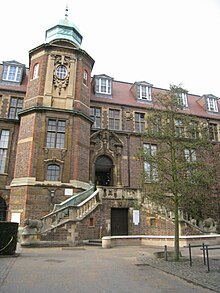Sedgwick Museum of Earth Sciences
 |
|
| Established | 1912 |
|---|---|
| Location | Downing Street, Cambridge, England, United Kingdom CB2 3EQ |
| Coordinates | 52°12′11″N 0°07′19″E / 52.20295°N 0.12206°ECoordinates: 52°12′11″N 0°07′19″E / 52.20295°N 0.12206°E |
| Type | Science museum |
| Collection size | 1.5 million specimens |
| Website | http://www.sedgwickmuseum.org/ |
The Sedgwick Museum of Earth Sciences, is the geology museum of the University of Cambridge. It is part of the Department of Earth Sciences and is located on the University's Downing Site in Downing Street, central Cambridge, England. The Sedgwick Museum is one of the eight museums which make up the University of Cambridge Museums consortium.
Dr John Woodward collected and catalogued over 35 years nearly 10,000 specimens in five walnut cabinets, two of which he bequeathed to the University in his will. The University later purchased another two, and the fifth was added in the 1840s. The cabinets are still in use today. He also left funds to establish the position of the Woodwardian Professor of Geology.
Adam Sedgwick began the process of expanding the collection, and purchased several ichthyosaur skeletons from Mary Anning. He persuaded the University to set aside space in the Cockerill Building, but by the time he died, the collection was too large for that space, so it was decided there should be a museum set up in his memory.
Construction of the Sedgwick Museum was supervised by Thomas McKenny Hughes, an astute negotiator who persuaded the University to build the museum, and raised over £95,000 by a public appeal. The museum was opened on 1 March 1904 in a ceremony attended by King Edward VII.
The Sedgwick has a collection of around 2 million rocks, minerals and fossils, spanning a period of 4.5 billion years. They are an important international resource for research, learning and enjoyment. They are not yet all available to search online but information about the collections is available on a number of sites via the Museum's website. The Brighton Building is a purpose-built geological conservation laboratory and collections store in West Cambridge. The Palaeontological Collection contains over 1 million fossils from across the world.
...
Wikipedia
